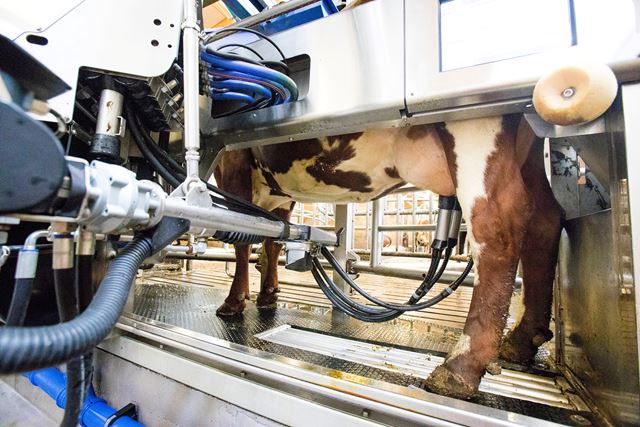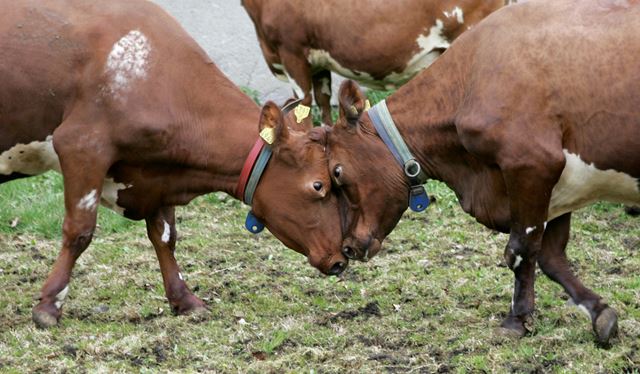The idea behind the new method is to combine data from the analysis of a cow’s milk with other information about the cow to predict future progression in the animal’s health.
“As we become more skilled at detecting this disease at an early stage, there will be benefits for animal health, milk production, profitability and the climate”, says Professor Olav Reksen at the Norwegian University of Life Sciences (NMBU).
The project is being coordinated by NMBU, with SINTEF and the Norwegian Institute of Food, Fisheries and Aquaculture Research (Nofima) acting as project partners. The research team has used data taken from milk sample analyses to develop a model that can detect the presence of the metabolic disease subclinical ketosis.
Critical period after calving
After calving, a cow’s energy requirements increase by between five- and six-fold. At the same time, she has to produce between 30 and 35 kilos of milk on the day after her calf has been born. This makes it easy for her to become energy-deficient.
“When a cow obtains too few carbohydrates, it resorts to burning its fat reserves in an attempt to get enough glucose”, explains Reksen. “Exactly the same thing happens when people fast. Under these conditions, a cow may contract metabolic diseases such as subclinical ketosis, among others” he says.
Healthy dairy cows help to keep a lid on Norway’s climate footprint. Norwegian cows have only half the footprint compared with the global average.
An invisible disease that creates problems
Clinical ketosis is a metabolic disease that is easy to identify and treat. The problem with subclinical ketosis is that it exhibits no visible symptoms, and is thus difficult to detect. Subclinical ketosis appears in between 15 and 20 per cent of cows after they have given birth. The condition causes poorer feed uptake, lower levels of milk production, reduced fertility and an increased risk of contracting other metabolic diseases. It is common for cows to be sick for between two and three weeks, but the disease may continue for longer. To date, it has only been possible to detect subclinical ketosis by means of blood tests.

Each month the dairies take samples from every cow that supplies them with milk. Photo: Håkon Sparre/NMBU
Investigating milk samples
In a recent study involving a total of 61 Norwegian Red cows, milk samples were taken one week before calving, and then again one hundred days after the cows gave birth. Milk composition in the samples was analysed using infrared spectrometry. Norwegian dairies regularly take samples of this type from all the cows that supply them with milk.
After calving, blood samples were taken from the 61 cows in order to find out if any had developed subclinical ketosis. The research team then analysed the fatty acid composition in the samples to see if there were any indications that might reveal the disease.
‘Fingerprints’ in the milk
After collating data from the milk samples with other information recorded for each cow, the researchers discovered a pattern, or ‘fingerprint’, that correlated with the presence of subclinical ketosis in the blood samples.
“This means that we can apply mathematical methods to data from standard milk samples to help us determine whether or not a cow has contracted subclinical ketosis”, says Reksen. “It also means that we no longer have to take blood samples”, he says.
“Once we’ve fine-tuned the method, dairy farmers will be able to get feedback directly from the dairy as to whether or not their cow has the disease”, explains Reksen. “A farmer can then take action to correct any energy deficiencies at an early stage, enabling the cow to stay healthy and fertile, as well as maintain its high levels of milk production.
Lots of mathematics
Amira Rachah is a research scientist at SINTEF Industry, and has been coordinating the mathematical work, as well as the big data and machine learning aspects of the project. Machine learning is used to analyse the large volumes of data involved. The researchers succeeded in building models that identified the systematic changes in fatty acid properties and composition of the milk samples from cows that were at risk of contracting subclinical ketosis.
“I believe that if dairy farmers have access to real-time data on each of their cows, we have the potential to revolutionise milk production”, says Rachah. “Farmers will be able to take informed decisions about nutrition and the care of their herds, which in turn will safeguard animal welfare and at the same time boost their profitability”, she says.

The aim is to develop a model that not only detects a disease before it breaks out, but which also prevents spread within the herd. Photo: Håkon Sparre/NMBU
Predicting disease
The research team has not yet succeeded in identifying the ‘fingerprint’ of subclinical ketosis in milk samples taken before calving. However, a new study has already been launched with the aim of extending the existing model. Half of Norway’s cows are currently milked by robots that gather individualised data on parameters including when a cow is milked and how much milk it produces.
“When we combine data on the composition of samples with those derived from the robots, we will have a better basis for the creation of algorithms that can identify the signs that will indicate the future development of subclinical ketosis”, says Reksen. “Our aim here is to be able to predict the onset of the disease before a cow actually becomes sick”, he says.
All cows are different, with their own individual characteristics
Reksen is keen to emphasise that no two cows are the same.
“The transition towards larger herds means that it is becoming even more difficult for dairy farmers to monitor the well-being of individual animals”, he explains. “All cows are different, with their own individual characteristics. This is why we need data from each individual cow”, he says.
Other diseases
Reksen believes that the method developed for the detection of subclinical ketosis can be applied to other diseases.
“So far, we have only investigated the early detection of subclinical ketosis”, he says. “However, the model is also able to reveal other diseases and health problems, such as mastitis, which also impacts on milk quality. Machine learning algorithms can also be used to develop models for predicting the likelihood of disease spread in the cowshed”, he says.
Reksen also believes that better livestock health monitoring is a key tool in the battle to mitigate climate change.
“Healthy dairy cows help to keep a lid on Norway’s climate footprint. Norwegian cows have only half the footprint compared with the global average”, he says.


